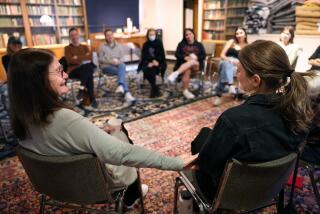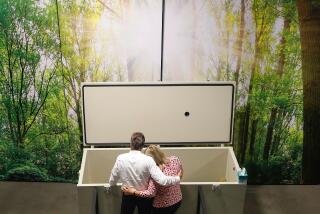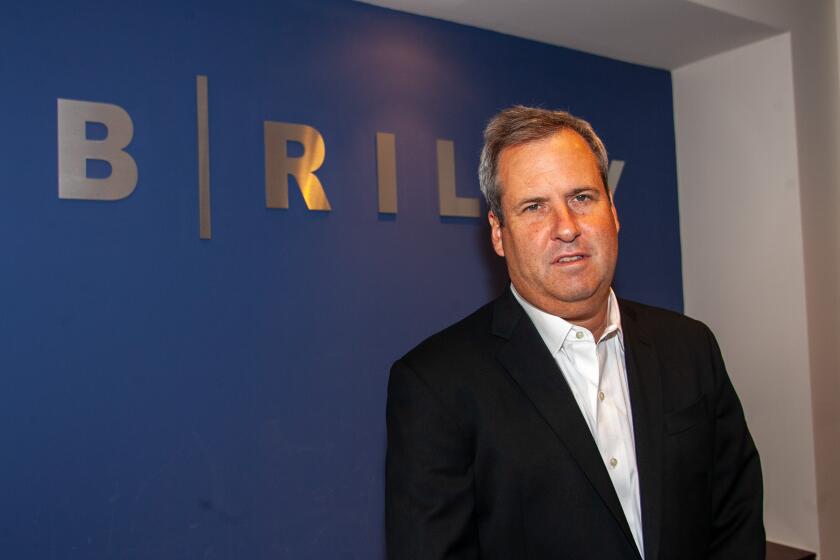Funeral Firms Feel Pressure of New Shoppers
Soured by seeing grief-ridden friends sold “incredibly expensive” funerals for loved ones, Mike McEligot began shopping when cancer seemed about to kill his father.
“I didn’t want to wait and do it when my family was vulnerable,” said the 44-year-old bank branch manager from Costa Mesa. “It’s like having to buy a car when your own car has already broken down.”
McEligot not only shopped, he wound up at a storefront funeral consultant, where he figures he bought a casket and headstone for about half the mortuary price. Then the consultant gave him a list of nearby morticians whose fees were lower than average.
The funeral was not cheap, McEligot said. Even with burial plots already bought, it cost $7,500. “If I hadn’t known better, it would have been way over $10,000. . . . I wasn’t going to shortchange my parents, but I kind of had the feeling that if I spent what the mortuaries wanted, my parents would have said, ‘What are you, nuts?’ ”
McEligot, a self-described “typical baby boomer,” represents the crest of a wave poised to engulf the funeral industry with demands for reasonably priced, often individually tailored celebrations of passage.
“That families would call and ask for prices was a shock,” said Bill McAulay, partner at McAulay & Wallace Mortuaries, established in Fullerton in 1911. “It just never happened. They came here because they knew my dad or granddad.”
Lisa Carlson, executive director of the nonprofit Funeral and Memorial Societies of America and oft-quoted critic of the funeral business, said the industry is not prepared to deal with baby boomers like McEligot. “I never thought people would buy a casket at a retail shop. I was astonished. I’m delighted.”
So far, the huge international funeral corporations--which handle 25% of the business in America and own an estimated 70% of all mortuaries in Los Angeles County, 60% in Orange County--have proved remarkably adaptable.
Where there has been competition from discount mortuaries and casket outlets, the corporations opened their own. When low-cost but profitable cremation societies sprang up, the corporations bought into that business.
“I don’t think at all that we’re going to see the end of the traditional funeral service,” said Brian Marlowe, executive vice president of Stewart Enterprises, one of the large international corporations. “But I think we’re going to need many more choices available.”
Baby boomers like “taking the responsibility away from the funeral director and putting it in the hands of the family,” said Stephen Prothero, assistant professor of religion at Boston University.
“They get to personalize the funeral. You now have the possibility of Bob Jones dying and being cremated and his family putting his ashes in his golf bag, taking it to the 18th hole at Pebble Beach, reciting his favorite golf poems and scattering his ashes over the cliff.
“It’s a ritual appropriate only to Bob Jones rather than the cookie-cutter ritual you get from a minister and a funeral director,” Prothero said. “They love it.”
Funeral reform became a hot topic in America with publication of Jessica Mitford’s 1963 best-selling expose “The American Way of Death.” But Carlson thinks the only significant change has been in the rate of cremation.
Seeking Alternatives to High Prices
Industry figures show that in 1963, fewer than 4% of deaths in America led to cremation. In 1997, the rate was 24% nationally, but much higher in New England and in Western states such as Nevada (61%), Washington (54%) and California (45%). Scarcity of land for burial seems not to be a factor. What state has more open land than Nevada?
The rise, Carlson believes, was inevitable once large corporations began buying up family-owned mortuaries and raising prices. “They’re pricing funerals to an obscene level where people think you shouldn’t just dig a hole in the ground and bury $9,000 in it.”
The Cremation Assn. of North America projects that by 2010, cremation will be chosen in 42% of all deaths nationwide. Along the West Coast, the figure will climb to 73% in Washington, 55% in California and 93% in Alaska, it predicts.
Casket manufacturers already have a line of cheaper, more easily combustible caskets for cremation. Cemeteries are making more room for scattering gardens and for columbaria, walls of niches to store ashes. Churches and universities are expected to eventually provide places to scatter or enshrine ashes.
Some who want to simplify funerals are turning to nonprofit memorial societies. They have been around for decades, trying to find local mortuaries and crematories willing to prearrange and discount their services to society members. But only after government regulations adopted in 1984 forced mortuaries to publish their prices did demand begin to rise for the societies’ cheaper funerals.
“So far as we’re concerned, the big change has been that undertakers are willing to cooperate with us now,” said Ruth Harmer Carew, a retired university professor and president of the nonprofit Los Angeles Funeral Society.
About 24 mortuaries throughout Los Angeles County have signed contracts with the society to get the society’s business. They provide simple cremations as cheaply as $450, simple funerals as low as $550, on the average about 20 a month.
Jerri Lyons is taking such societies a step further. She helped form the Natural Death Care Project in Sonoma County to teach people how to tend to their own dead without morticians.
“This is for families who don’t want to use a mortuary at all,” she said. “I think it’s growing, slowly, because of the high cost of death and because baby boomers, my generation, are looking for alternatives.”
She said that in three years, she has helped 80 families lay out, commemorate and deliver their loved ones to crematories and cemeteries.
The funeral industry can take comfort in the fact that death is a growth industry.
In Orange County, for example, the annual death rate--6 per 1,000 population--has held steady since the early 1970s. A growing population, however, still makes for increased demand.
“Just based on volume, there will be an increased need for services,” Marlowe said.
Over the last decade, the big three international companies--Service Corp. International (SCI) of Brentwood, Tenn., the Loewen Group of Burnaby, British Columbia, and Stewart Enterprises of New Orleans--have been acquiring mortuaries, cemeteries and crematories at an increasing rate, concentrating on high-volume locations in urban and suburban areas.
Service Corp., the largest by far, had 850 locations in 1992. Five years later it had 3,700 locations. During that period, revenues climbed to nearly $2.5 billion.
Carlson said surveys show that when corporations acquire a local mortuary or cemetery, they seldom change its name, managers or appearance but almost always raise its prices.
Trend Creates Competition
The trend has spawned competitors, most notably about 150 discount casket retailers nationwide.
Most tend to locate across the street from corporate-owned cemeteries, where they beckon deal-conscious baby boomers.
That’s where Tom Oswald sits, across Beach Boulevard from Service Corp.-owned Westminster Memorial Park, offering his services as a funeral broker and discounter of caskets and headstones.
“I knew this was coming,” Oswald said. “Now there are seven casket stores in Orange County alone. This business is changing so fast.”
Angus McAulay thinks he’s riding the right wave, too. He was a partner with his brother at McAulay & Wallace Mortuaries in Fullerton. He sold his share and now runs New Options Funeral and Cremation Services from his home in Placentia.
He still has his funeral director and funeral home licenses, but he has no casket sales room, no chapel, no viewing room--only his home office and an embalming room tucked inside a Fullerton industrial park.
McAulay comes to your home to make arrangements at cut prices. He said he has had nearly 100 customers since he opened in September 1997.
He’s taking aim at baby boomers, he said, because “they’re looking for value. They’re shopping on the Internet. I’m looking to set up a really nice Web site. I think this will become a strong, grass-roots type thing.”
Reformers as well are hoping for public support. They are hoping to prod new laws and regulations at the state and national levels.
The Federal Trade Commission is poised to consider further funeral industry regulations next year, and reformers are gearing up for the fight.
Until recently, Karen Leonard of the Redwood Funeral Society did the lobbying for all California societies, and it was all uphill. It took 14 years to repeal California’s ban on private scattering of ashes, a law she said was never enforced. It will disappear from the books Jan. 1.
Reformers now plan to lobby for a board to act as watchdog for the California funeral industry, Leonard said. “After six years of watching how Sacramento works, I can tell you the consumer will have no protection until you have that board.”
(BEGIN TEXT OF INFOBOX / INFOGRAPHIC)
Web Sites on Funeral Choices
National Funeral Directors Assn.: This site, offered by the world’s largest funeral service organization, offers important resources to both the consumer and the funeral service professional. Read about current trends, issues and career opportunities as well as find helpful publications on planning a funeral and dealing with grief.
https://www.nfda.org/
Forecast, April 1997: The Information on Cremation: Find out why cremation is increasingly being chosen and what creative ways baby boomers have come up with to dispose of their ashes.
https://www.demographics.com/publications/fc/97_fc/9704_fc/fc97044.htm
The History of Cremation: Learn about cremation from its beginnings in the early Stone Age to the present day. https://www.cremationinfo.com/cope/history.html
Funerals--Death and Dying Netlinks: This useful collection of sites explains embalming, cremations and memorial services and gives tips on how to save money on funerals.
https://dying.miningco.com/msub8.htm
Find a Grave: View the grave sites of many notable people through this searchable database.; https://www.findagrave.com/
Los Angeles Funeral Society: Includes various publications including low-cost funeral options, how to donate your body to science, helping grieving people and alternatives to traditional funerals. Fee requested. P.O. Box 92313, Pasadena, CA 91109; (626) 683-3545; https://vbiweb.champlain.edu/famsa/lafs.htm
Funeral and Memorial Societies of America: Information on funerals, funeral options and funeral industry trends. Also includes online bookstore, ombudsman and funeral humor. P.O. Box 10, Hinesburg, VT 05461; (800) 765-0107; https://www.funerals.org/famsa
California Department of Consumer Affairs, Cemetery and Funeral Programs: Guidelines for making decisions about funeral and cemetery arrangements, how to file a complaint and how to find out if a cemetery is licensed. 400 R St., Sacramento, CA 95814; (800) 952-5210; https://www.dca.ca.gov/cemetery
*
Other sources:
Cremation Assn. of North America: 401 N. Michigan Ave., Chicago, IL 60611; (312) 644-6610. Send return envelope with 78 cents postage.
Tri-County Memorial Funeral Society (Orange, Riverside, San Bernardino): P.O. Box 114, Midway City, CA 92655; (714) 962-1917
More to Read
Inside the business of entertainment
The Wide Shot brings you news, analysis and insights on everything from streaming wars to production — and what it all means for the future.
You may occasionally receive promotional content from the Los Angeles Times.










